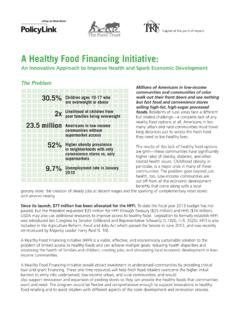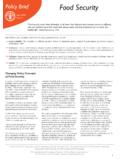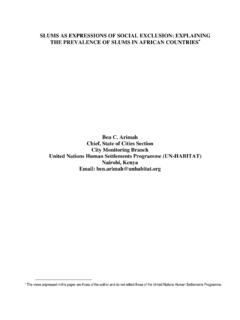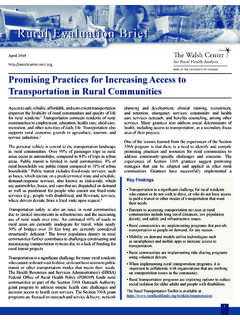Transcription of Occupational Health and Safety in China
1 299 The status of Occupational Health and Safety con-ditions in China is an issue of growing impor-tance to Health professionals, labor rightsorganizations, local factory operators, multinationalcorporations, consumers, and, of course, Chinese work-ers. Over the last decade, China has emerged as the world s factory floor. Occupational Health and safetylaws, regulations, and implementing agencies are strug-gling simply to keep up with the current explosive eco-nomic growth. Occupational Health and Safety is, of course, not newto China . However, the dramatic economic and socialchanges occurring over the last 20 years in China areunprecedented in human history. No country has everindustrialized as fast as China . No country has ever facedas many new types of industries and hazards in such ashort time. No country has ever experienced such a rapidtransition from rural agricultural to urban industrialliving.
2 This industrialization is thus just now beginning toreceive rigorous and sustained examination in terms ofits impact on environmental and Occupational Health . This special issue of IJOEH seeks to highlight someof these impacts, looking in detail at actual factory con-ditions, current regulatory laws and enforcement, Occupational Health and Safety research, and emergingstrategies for improving workplace Health and Safety inChina. Naturally, it is impossible to cover all that isgoing on in China . This special issue is meant only tobe a contribution to the limited literature available inEnglish on China s factory conditions, their impacts onChinese workers, and the broader impacts on work-place practices throughout the global economy. Factories in China now produce 70% of the world stoys, 70% of photocopiers, 40% of microwave ovensand sports shoes, and increasing shares of the world svideotape and DVD equipment, cell phones, electriclighting, and semiconductors and circuit boards.
3 In2002, China s exports reached $322 billion, with anoverall trade surplus of $30 billion, and China becamethe fifth largest trading nation in the world behind theUnited States, Japan, Germany, and France. Shenzhenin the Pearl River Delta became the sixth largest port inthe world in 2001, surpassing both Rotterdam and LosAngeles. Hong Kong alone sends 6,000 shipping con-tainers of consumer goods to the United States everyday. China s trade surplus with the United States was$ billion in 2002, and China has displaced Japanas the United States number three trading partner,after Canada and the midst of lackluster economic growth globally, China s economy grew in 2001 and 8% in 2002,and is projected to grow another 7% in 2003. Foreigndirect investment (FDI) amounted to $ billion in2002, and is expected to increase by another $86 billionin the next two years.
4 In 2001, China received moreFDI than South Korea, Thailand, Malaysia, Singapore,Vietnam, and Indonesia ,8-10 China has also made the crucial leap, which otherexport platforms such as Mexico have not achieved, toproduce locally component parts for factories supply-ing global consumers, and to produce goods for anexpanding middle-class domestic market. For exam-ple, Flextronics export products now include 50 70%locally-made parts in China , up from 5 10% just fouryears a population of billion, China ispotentially the largest domestic market in the world, amarket that increasingly demands goods and servicesof its own. Special IssueOccupational Health and Safetyin ChinaGuest EditorsGARRETTD. BROWN, DARAO ROURKEThe Race to China and Implications forGlobal Labor StandardsGARRETT D. BROWN, DARA O ROURKEIn the 2000 census, China reported an economicallyactive population of million people (which grewto million by the end of 2001).
5 These workerswere 33% in urban areas and 67% in rural zones, with50% (354 million) in agriculture, forestry, and fishing;23% (162 million) in mining and manufacturing; and27% (190 million) in services and government. Workersin state-owned and collective enterprises declined of the working population in 2001, from 98% twodecades earlier. The number of workers migrating fromthe countryside to urban areas in search of work is esti-mated to be between 80 and 150 million ,12It is impossible to characterize in a brief snapshot theworking conditions for such a large and varied work-force. However, a rough sense of the state of workplacehealth and Safety can be gleaned from official statistics. The International Labor Organization estimatesthat China s 2001 workplace fatality rate was per100,000 workers, compared with a rate of per100,000 in the United States. Industrial accidents roseby 27% between 2000 and 2001, while Occupational dis-eases increased by 13% in the same period, accordingto government statistics.
6 The government workplacehealth and Safety agency reported that 140,000 workersdied on the job in 2002, a rate of 380 deaths a ,13 The impacts of Occupational Health and Safety con-ditions in China , however, are not simply local. As othercountries compete with China to attract FDI and jobs,conditions in China are effectively setting the floor for conditions in factories in the rest of the global econ-omy. Workplace practices in China wages, hours,treatment of unions, investments in Health and Safety ,etc. exert tremendous pressures on higher-cost pro-ducers in both developed and developing economies tomatch these practices, or to reduce costs related tocompliance with Health and Safety regulations andlabor practices in their own countries. The articles in this special issue can only scratch thesurface of current conditions and regulatory practicesin China , and identify key areas where further researchand policy analysis are needed.
7 Our goal is to generateinterest in issues that will increasingly affect occupa-tional Health professionals around the world, raisequestions about current conditions and policies inChina, and solicit ideas and proposals for protectingthe Health and Safety of workers in China , and in otherloci of the global economy. We begin with a discussion of laws and implementa-tionin China . Deputy Director General of the Ministryof Health in the department of legislation and inspec-tion, Dr. Zhi Su lays out the background to and con-tents of the newly implemented Occupational healthand Safety (OHS) laws. Hong Kong based researchersTim Pringle and Stephen Frost assess the componentsand prospects for actual enforcement of these Frost supplements these discussions of gov-ernment laws with an analysis of the real rules thatgovern workers lives extensive and aggressivelyenforced factory then turn to detailed descriptions of actual con-ditionson the factory floor in China .
8 Industrial hygien-ist Garrett Brown blends personal experience, existingresearch, and investigative reports by the mass mediaand nongovernmental organizations in a sweepinganalysis of current conditions in workplaces through-out China . Veteran China -based journalist E. Griggers-Smith reports on the high personal cost to workers ofunsafe conditions. Economist Boy Luethje of Germanyprofiles the booming electronics industry in human rights director Jill Tucker describeschanges in the demographics of women migrant work-ers in foreign-invested enterprises in China producingfor the shoemaker, and one program to respondto these women s needs. Very little rigorous academic researchon OHS issuesin China has been reported in English to date in Wang and David Christiani provide anoverview of one key area Occupational lung disease and related research needed in China . Janice Campand colleagues at the University of Washington reporton a new research project with textile workers inShanghai and its organization.
9 China offers uniqueopportunities for Occupational Health research, due tothe legacy of long-term employment, stable manage-ment, and continuous exposures in the centrallyplanned economy, but this advantage is slipping awayin the rapidly changing economic order. Meei-ShiaChen analyzes how, in the past, Chinese workers havebeen able to act directly to protect their Health andsafety through two key workplace institutions thetrade union and the staff and workers representativecongress and how these institutions and workers par-ticipation have changed since the mid-1990s. Capacity building and trainingare also critical toresponding to current workplace challenges. Betty Szudy,Dara O Rourke, and Garrett Brown describe a first-of-its-kind capacity-building project bringing together interna-tional sports shoe brands, local contractors, HongKong based labor rights organizations, and productionline workers in the three huge shoe plants in the PearlRiver Delta.
10 The project included a four-day trainingprogram at a 30,000-worker factory that resulted in theestablishment of Health and Safety committees withmeaningful participation by workers in three , we conclude with an analysis of policyoptions and incentivesfor improved workplace prac-tices and regulation in China . Dara O Rourke and Gar-rett Brown analyze current challenges and impedi-ments to improving conditions in factories in China ,and propose a set of policy strategies to create realincentives for multinational firms to improve condi-tions in their supplier factories, and for local govern-ment agencies to strengthen their enforcement ofexisting regulations. 300 Brown, O INT J OCCUP ENVIRON HEALTHR eferences1. Bradsher K. US official cites progress in trade ties with York Times, Feb 20, Reuters. US trade deficit hits new highs in December and 20, Kynge J, Roberts D.







